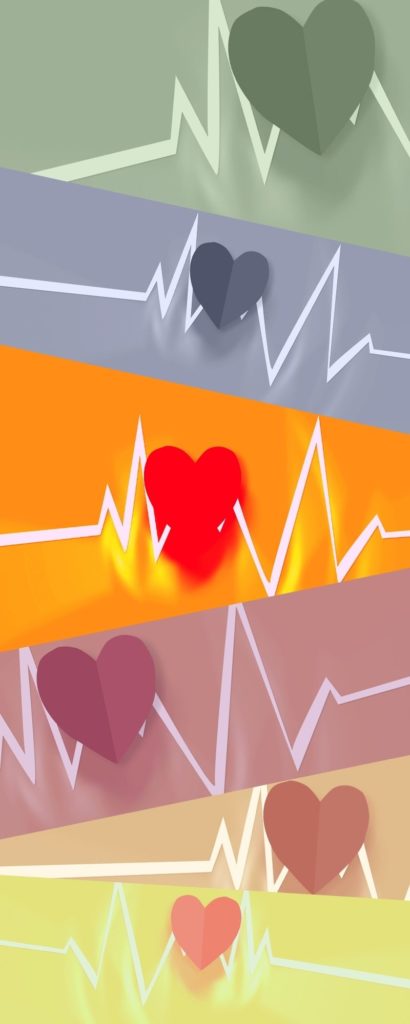Heart Rate Variability Optimisation: The Underrated Index of Health
The heart is an inconstant thing. No, I’m not talking metaphorically about the difficult-to-articulate reasons you prefer one Survivor competitor over another, or your changing taste in music from one day to the next. On a more practical level, your heart is inconstant- or rather, it should be. A healthy heart operates with varying gaps between two consecutive heartbeats. So even if you sit on a cool 60 beats per minute, your heart wouldn’t be uniformly beating once a second. These differences in pace are referred to as Heart Rate Variability (HRV). Here we look at why HRV matters and what you can do to enhance yours.
Key points:
- High Heart Rate Variability (HRV) is generally (but not exclusively) linked with improved health and lower rates of diverse conditions, from asthma to PTSD.
- A complex network of factors interact to determine Heart Rate Variability. The nervous system, hormones, chemical and blood pressure receptors, circadian rhythm, metabolism and body temperature to name a few.
- High cardiovascular fitness is associated with high HRV. Initiating new cardiovascular exercise programs, however, has produced mixed results in the research.
- Biofeedback can be used to greatly enhance HRV
Heart Rate Variability and health

Generally, a high Heart Rate Variability is a good sign for health. This is because it means the heart can agilely respond to sudden psychological or physiological changes. Diseases are often associated with less HRV. On the other hand, there are also cases where more variability is a negative thing, for example it can be increased in atrial fibrillation (a form of heart arrhythmia).
HRV has been associated with and may be a useful predictor of morbidities from both mental and physical conditions (including stress, depression, anxiety, PTSD, inflammation, chronic pain, diabetes, concussion, asthma, insomnia and fatigue). A nervous system stress response likely mediates a two-way effect of HRV on these conditions and vice versa, leaving potential for vicious cycles.
Although there are stats on the HRV of elite athletes and different norm tables have been published, it is not completely clear what a “good” or “bad” HRV is. You don’t need to panic if your HRV is less than an Olympic marathon runner’s!

A study that used 24 hour monitoring of the heart suggested that, if the standard deviation from the average period between normal beats was less than 50 ms, patients were classified as unhealthy; if 50–100 ms, they were in compromised health, and above 100 ms, they were healthy. Recommended ranges such as these are the best we can currently do due to the complexity of HRV and the likely variations between one demographic and the next. However, it has been suggested that any norms should still be adapted by clinicians to suit the characteristics of a particular sub-population. This would rely on the clinician’s personal experience as well as empirical evidence.
The relationship between resting heart rate and health has been easier to delineate: resting heart rates above 90bpm have been associated with increased mortality. In the absence of precise guidelines or readily accessible equipment for HRV measurement (see below), aiming for a lower resting heart rate is a good start. Keep in mind also that if your resting heart rate is lower, there is more room for your heart rate to vary in response to changing physiological stimuli.
How is Heart Rate Variability controlled?
The whole picture of HRV is quite difficult to encapsulate as multiple factors interact to affect, and respond to, HRV. To give you an idea of how complex it is, it’s described as ‘mathematical chaos’. If mathematicians can’t provide adequate formulas or models to summarise or predict how a heart rate will vary, I’ve got buckley’s. However, this chaos is what allows a heart to respond to an uncertain environment and changing needs.

Over short periods of time, the balance between stimulating and relaxing branches of the nervous system, the cardiovascular, hormonal, respiratory and digestive systems, receptors for blood pressure and chemical levels, and possibly facial muscles combine to regulate HRV. A reflexive relationship between blood pressure, vessel diameter and heart rate is particularly strong. The nervous system also has a large role- in particular, the vagus nerve (of the parasympathetic nervous system, i.e. the one responsible for resting, digesting and soothing functions) mediates high HRV. This increased HRV is in turn linked to greater attention and emotional processing capabilities in the brain.
Over the course of an entire day, HRV will also alter under the influence of circadian rhythm, body temperature, metabolism, the sleep cycle, and the renin–angiotensin system (a hormone system involved in blood pressure, fluid and electrolyte control).
How do you measure your Heart Rate Variability?
It’s not a simple DIY project. Commercially available devices do not cut the mustard. You require ECG or Blood Volume Pulse measures, which means accessing clinical services with high-grade equipment. Some research facilities have provided measures of HRV over a period of minutes, although longer recording periods (ideally 24 hours) provide much greater prognostic strength.
Regardless of the duration of a test, there are a number of different measurements that can be made (time-domain, frequency-domain, and non-linear metrics among them), each providing data from a different angle. Results vary according to which metric is used, as well as the situation in which the test is performed.
Abnormal beats from cardiac abnormalities could be confused as HRV, and hence they are usually excluded from analysis.
Optimising your Heart Rate Variability

You can’t stop yourself from getting older, which tends to decrease your HRV. However, keeping yourself physically fit *should* help. The clear trend of elite athletes having high HRV supports this notion. In terms of evidence from studies- there are mixed results regarding the effect of cardiovascular exercise programs on Heart Rate Variability. This could be due to poor control for other factors that may influence participants’ responses, and which could make comparison between studies untenable. It has also been suggested that higher intensity exercise may produce greater improvements, although studies are not consistent in their intensity selection. Further research is necessary to clarify these issues.
Biofeedback may also be used to improve HRV, although this also requires specialist technology. You are hooked up to machines to measure and display your pulse and breathing rate. With slow, paced breathing (usually 4.5-7.5 breaths/minute), people are able to optimise the acceleration of their heart rate (which happens during inhalation), and the deceleration of their heart rate (during exhalation). Together, this can greatly increase HRV compared to your ‘normal’ resting HRV levels. A sine-wave-like curve on the monitor indicates this achievement, thus providing a visual tool to help you control your HRV. This pattern has been associated with the most efficient gas exchange between lungs and blood. Furthermore, a variety of conditions seem to be improved with such biofeedback. These include asthma, COPD, IBS, cyclic vomiting, recurrent abdominal pain, fibromyalgia, hypertension, chronic muscle pain, high blood pressure during pregnancy, depression, anxiety, PTSD, insomnia, and performance.

The mechanism by which biofeedback works is not fully understood, although it is thought that the nervous system and feedback from blood pressure receptors play key roles. Some people have also hypothesised that benefits might relate to a meditative effect of the task, the stretching of airways (for asthma sufferers), and anti-inflammatory effects.
Of course controlled studies are needed to clarify whether there’s a cause-effect relationship between biofeedback and conditions, and to determine mechanisms, but so far we can say there’s potential.
The Verdict
Higher Heart Rate Variability is generally an indicator of health. Performing regular cardiovascular exercise may be a sensible, accessible way to increase or maintain your HRV. While the results on this matter are inconsistent, we do not know if this is reflective of exercise not actually always helping, or if it’s the result of inadequacies in research protocols. In the worst case scenario, cardiovascular exercise will provide a myriad of other heart and general health benefits. The use of biofeedback devices through specialist clinics also has potential to improve Heart Rate Variability, and various associated conditions.
What do you want to know about heart health?
References
Cornelissen, V., Verheyden, B., Aubert, A. et al. (2010). Effects of aerobic training intensity on resting, exercise and post-exercise blood pressure, heart rate and heart-rate variability. J Hum Hypertens 24, 175–182 https://doi.org/10.1038/jhh.2009.51
Lehrer, P.M., Gevirtz, R. (2014). Heart rate variability biofeedback: how and why does it work? Frontiers in Psychology , 5, DOI=10.3389/fpsyg.2014.00756
Shaffer, F., and Ginsberg, J.P. (2017) An Overview of Heart Rate Variability Metrics and Norms. Frontiers in Public Health, 5. doi:10.3389/fpubh.2017.00258

A well-written article.
So… I should go for a jog now? 🙂
A jog sounds like a fabulous idea for your HRV Alex! Walking, hockey, dancing, anything else that gets your heart pumping is also great 🙂